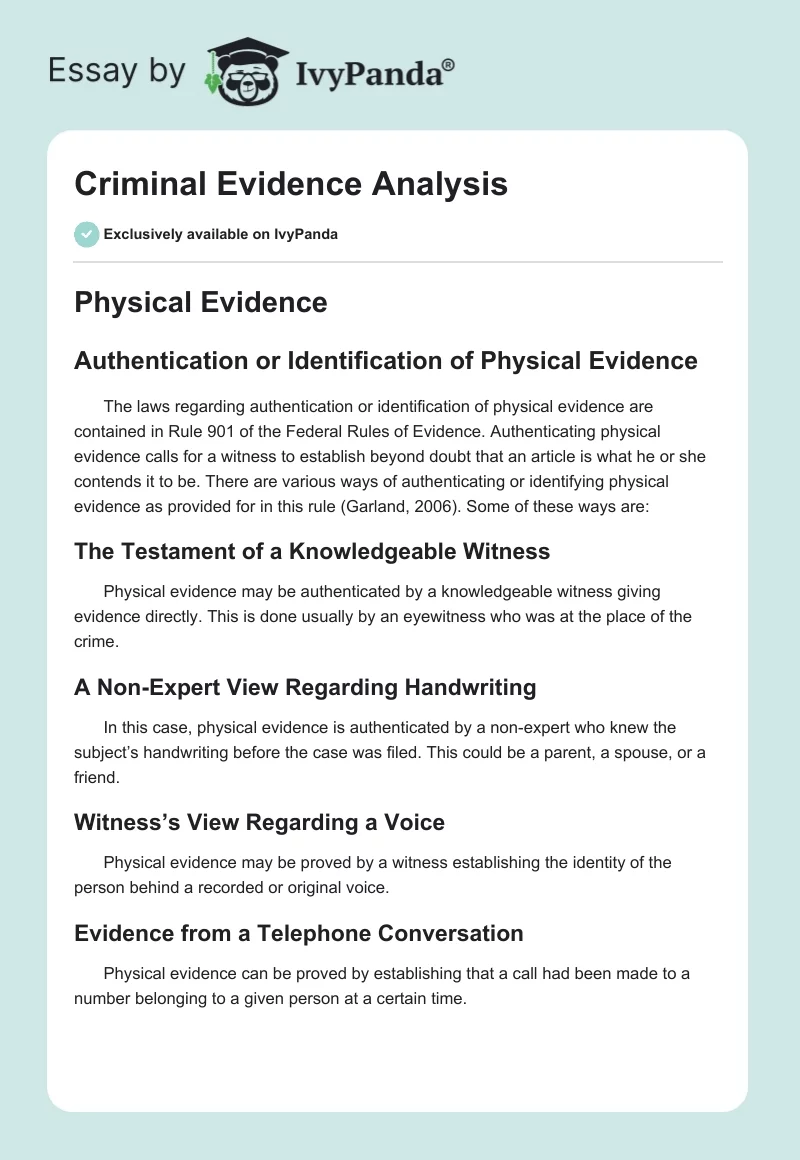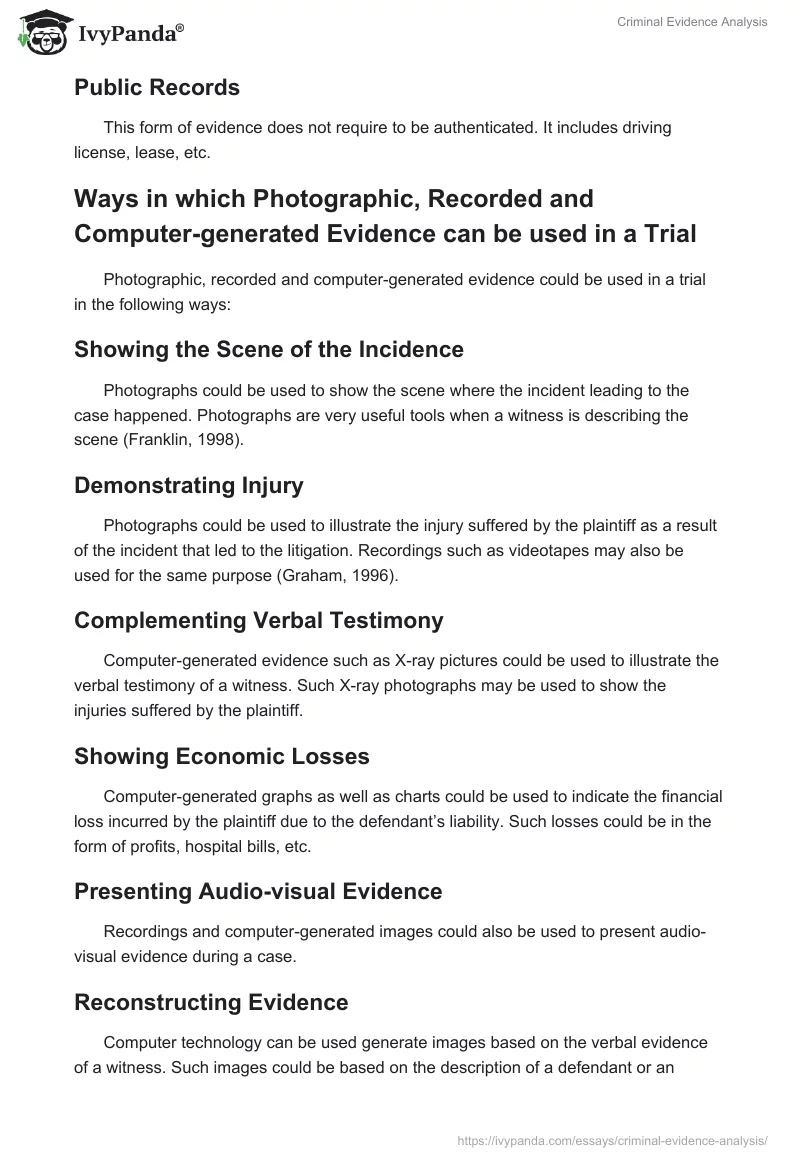Physical Evidence
Authentication or Identification of Physical Evidence
The laws regarding authentication or identification of physical evidence are contained in Rule 901 of the Federal Rules of Evidence. Authenticating physical evidence calls for a witness to establish beyond doubt that an article is what he or she contends it to be. There are various ways of authenticating or identifying physical evidence as provided for in this rule (Garland, 2006). Some of these ways are:
The Testament of a Knowledgeable Witness
Physical evidence may be authenticated by a knowledgeable witness giving evidence directly. This is done usually by an eyewitness who was at the place of the crime.
A Non-Expert View Regarding Handwriting
In this case, physical evidence is authenticated by a non-expert who knew the subject’s handwriting before the case was filed. This could be a parent, a spouse, or a friend.
Witness’s View Regarding a Voice
Physical evidence may be proved by a witness establishing the identity of the person behind a recorded or original voice.
Evidence from a Telephone Conversation
Physical evidence can be proved by establishing that a call had been made to a number belonging to a given person at a certain time.
Public Records
This form of evidence does not require to be authenticated. It includes driving license, lease, etc.
Ways in which Photographic, Recorded and Computer-generated Evidence can be used in a Trial
Photographic, recorded and computer-generated evidence could be used in a trial in the following ways:
Showing the Scene of the Incidence
Photographs could be used to show the scene where the incident leading to the case happened. Photographs are very useful tools when a witness is describing the scene (Franklin, 1998).
Demonstrating Injury
Photographs could be used to illustrate the injury suffered by the plaintiff as a result of the incident that led to the litigation. Recordings such as videotapes may also be used for the same purpose (Graham, 1996).
Complementing Verbal Testimony
Computer-generated evidence such as X-ray pictures could be used to illustrate the verbal testimony of a witness. Such X-ray photographs may be used to show the injuries suffered by the plaintiff.
Showing Economic Losses
Computer-generated graphs as well as charts could be used to indicate the financial loss incurred by the plaintiff due to the defendant’s liability. Such losses could be in the form of profits, hospital bills, etc.
Presenting Audio-visual Evidence
Recordings and computer-generated images could also be used to present audio-visual evidence during a case.
Reconstructing Evidence
Computer technology can be used generate images based on the verbal evidence of a witness. Such images could be based on the description of a defendant or an important witness whose presence is necessary in the case but who is still at large. These reconstructions are useful for identifying the missing defendant or witness especially through publication (Franklin, 1998).
Miranda
The Requirements for Miranda
- Informing the relevant persons that they are entitled to remaining silent and that anything they say could be used against them during trial.
- Informing the relevant persons that they are entitled to consulting their attorney before being questioned by the police.
- Informing the relevant persons that they have the right to an attorney during questioning.
- Informing the relevant persons that if they cannot afford an attorney, one will be availed to them at no cost (Lawrence, 2005).
Meaning of Custody
According to Miranda, custody refers to substantial restriction of a person’s freedom of movement through formal arrest (William, 2008).
Meaning of Interrogation
Under Miranda, interrogation implies direct questioning of the suspect with the view of extracting incriminating evidence (William, 2008).
Exceptions to Miranda Requirements
Routine Booking Question Exception
Routine questions asked during the arrest process which are not intended to extract incriminating evidence are not taken as interrogation.
Jail House Informant Exception
This exception relates to a situation where the suspect is not aware that he or she is talking to a state agent when producing incriminating statements.
The Public Safety Exception
This exception operates when the police are of the view that public safety is in peril (William, 2008).
Exclusionary Rule
The Creation Process and Purpose of the Exclusionary Rule
The Exclusionary rule is enshrined in the US constitution and it prohibits the use of evidence which has been extracted from defendants in contravention of their constitutional rights. This rule emerged in the Height case of 1902, where a physical exam done on the defendant contrary to his will was to be used as evidence in that case. The purpose of the rule is to prevent the breach of defendants’ constitutional rights during the gathering of prosecution evidence by the police (Graham, 1996).
The Fruit of the Poisonous Tree Doctrine
This doctrine states that any evidence obtained illegally is inadmissible in a court of law in the US. The tree here denotes the source of the evidence while the fruit is the evidence. The fruit (evidence) is poisonous because it was got from a defiled source (Lawrence, 2005).
The Independent Source Doctrine
This doctrine is an exception to the exclusionary rule. It states that, if some of the evidence got from a tainted source was obtained independently and from an untainted source, then this evidence is admissible in a court of law (William, 2008).
Search and Seizure
Warrant Requirement
The warrant requirement rule protects citizens from unreasonable searches and seizures by the government.
Exceptions to the Rule
In the Case of Lawful Arrest
Police have the authority to search the person and surroundings of an individual who has been lawfully arrested.
The Plain View Principle
Where the law enforcers are standing at a point from which physical proof can be seen, a warrant is not necessary for capturing such proof.
Affirmation
If the authorities get a go-ahead for searching a premise and taking evidence with them from a person whom they believe to possess such authority, then no warrant is necessary.
Stop and Search
The law enforcers have the right to search a suspect if they are sufficiently suspicious that he or she has perpetrated a crime.
Vehicles Exception
As vehicles can move fast, a search warrant is not necessary provided the police can establish that they had sufficient cause to suspect that a vehicle has criminal evidence.
Emergencies
This exception relates to evidence that can easily disappear. In such a case, a search warrant is not required (William, 2008).
Situations Deemed to be Exigent
The Exigency rule provides leeway to the police to rummage a premise without a warrant under specific situations. These circumstances are:
- Where there is need to protect the police or other individuals from physical injury.
- Where evidence may be destroyed
- Where the suspect may escape and;
- Where another incident can frustrate enforcement of the law (Garland, 2006).
References
Franklin, C. (1998). Miranda and Stansbury Case: An Analysis. New York: Alt.law-enforcement.
Garland, N. (2006). Criminal Evidence. Boston: McGraw Hill Publishing.
Graham, H. (1996). Common Law Systems in Fundamentals of American Law. New York: Oxford University Press.
Lawrence M. (2005). A History of American Law. New York: Touchstone.
William, B. (2008). Introduction to the Law and Legal System of the United States. London: Thomson West.


